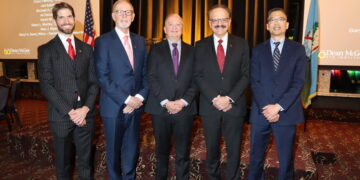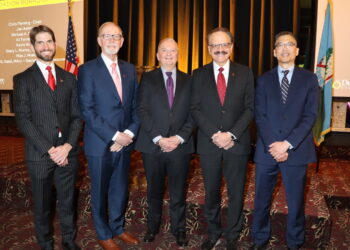OKLAHOMA CITY (OBV) – The Oklahoma Workforce Commission will meet for the first time on Nov. 27, beginning their quest to grow the state’s workforce; and a commission member said Oklahoma CareerTech is a core component in that mission.
The Workforce Commission was created when Gov. Kevin Stitt signed Senate Bill 621, written by Sen. Adam Pugh, R-Edmond, and Rep. Brian Hill, R-Mustang, into law in June.
The Workforce Commission will work to coordinate the state’s workforce efforts. Their objective is to streamline workforce processes into a more efficient and effective system that will grow the economy and produce greater numbers of skilled workers.
Business leaders across Oklahoma say the shortage of skilled workers is their most pressing concern.
The State Chamber Research Foundation released the 2023 Business Leaders Poll this past summer. The poll is concerned with understanding the nature of workforce challenges Oklahoma businesses face. SCRF surveyed business leaders about struggles in filling skilled positions, workforce quality and availability concerns and the importance of education in growing the workforce.
Fifty percent of business leaders who participated in the poll said skilled, credentialed workers is the most difficult vacancy to fill. The need for more skilled experienced workers is also the primary reason most employers, 29 percent, do not rate the available workforce higher. This theme continues with 50 percent of business leaders saying finding employees with durable skills is their greatest concern when it comes to the available workforce.
Most business leaders, 49 percent, agree that Oklahoma’s education system must be more focused on providing students specialized skills that will meet workforce needs in the state.
Oklahoma Career Tech has been working for decades to grow the state’s workforce through vocational education that equips young Oklahomans with the skills they will need to enter the workforce career-ready after high school.
Edward Hilliary Jr., co-CEO of Hilliary, has been a member of the Oklahoma CareerTech Board of Education since April 2021. He is also a member of the newly minted Oklahoma Workforce Commission. He says Oklahoma’s workforce system, including CareerTech, is effective, but there is room for improvement.
“Overall, I think we do a good job with workforce. I think it’s the coordination between the different groups and knowing what is needed to turn that around and to expand it to areas that are growing the fastest,” Hilliary said. “I’m on the state CareerTech board, and one thing that we do a great job of is when somebody comes to us with a new need, we can put a program up in months. I mean, it goes quick – we get a program, we get training going, but I don’t think we do a good job about making sure everybody knows that programs are getting out to the students, getting out to people that are unemployed, trying to figure out a career or looking to better themselves from their existing career to know that there’s a program going, working with higher ed to truly turn around and say, ‘Okay, we’re doing this; what are y’all doing that we can maybe put a full program together to make sure we’re training everything up what somebody needs?’ So, I think it’s the coordination between all of our different organizations and even pull from the private industry saying, ‘Okay, this is what I got, this is what I’m looking at. Okay, what can y’all do to help and help me to meet that goal?’”
CareerTech has done a good job working with school districts on career-focused education and training, according to Hilliary. He said it’s essential that the State Chamber rely upon CareerTech when developing workforce initiatives.
“I think it’s very important. I do think it’s still just one piece. I think the relationship between CareerTech, higher ed and K-12 is the most important piece of the whole thing. The way that they work together, the way that they can develop programs to whether you’re going through CareerTech, making sure that those programs that we’re offering are on the level that schools and Oklahoma will give you college credit for it,” Hilliary said.
CareerTech is a dynamic entity that knows how to adapt to industry changes to build the workforce of the future, Hilliary said.
“I think the CareerTech is the most nimble of the three parts; we can pivot and change programs and adapt new programs the best and the fastest because we’ve got these individual schools in place throughout that are already doing that, throwing up programs as they’re needed and working with the individual schools or the colleges,” Hilliary said.
Oklahoma CareerTech will be involved with the Oklahoma Workforce Commission since they will be helping with strategic solutions for growing the workforce, according to Hill.
“As someone who has toured half the campuses across the state, I’m very passionate about them,” Hill said. “I think their voice is in the part where the commission looks and hears from industry and what is actually needed by industry, and then connects it to CareerTech higher ed and those providers.”
Better coordination between workforce sectors is the biggest improvement needed, Hilliary said. He expects coordination of those silos to be top priority for the commission, Hilliary said.
“I believe a [top priority] to bring all of our different sectors together from private, public, higher ed or career tech. I think we have a great, great systems and we’re doing a good job overall and individually with helping meet our workforce needs, Hilliary said. “But I don’t think there’s good coordination between everybody, and the fact that everybody knows what’s going on and can smoothly work together to make that happen, along with what the legislators are doing and the money they’re putting out, I just think there’s a smoother way and just a better way to make sure that we’re meeting those needs.”
It was a long road to get to reach the Workforce Commission
SB 621 was born from research which revealed a workforce deficiency in Oklahoma. A State Chamber and Business Roundtable joint survey found that 60 percent of Oklahoma’s business community said workforce shortages were the number one threat to business growth and expansion. Chad Warmington, president and CEO of The State Chamber of Oklahoma, and Ben Lepak, executive director of the State Chamber Research Foundation, provided Stitt and legislators research data which showed that Oklahoma was 36,000 workers deficient in filling available jobs.
It was determined that a new, focused workforce management system was needed to grow the state’s workforce and fill the thousands upon thousands of available jobs.
“What we learned very quickly was there’s a lot of good people in Oklahoma doing good work on workforce, but there was no collaboration or coordination between those entities,” Warmington said during the signing ceremony. “There was none. No one owner of workforce who at the end of the day, the governor and the legislature could point to and say, ‘Why do we have workforce shortages and what are we going to do to fix it?'”
The Oklahoma Workforce Commission will direct the state’s workforce development strategy and administer and oversee funding allocated by the legislature for workforce development initiatives. The commission can contract with outside parties to achieve its goals.
“How can we ensure across the entire enterprise of systems and agencies, and individuals and entities that build our workforce, how can we ensure we are creating men and women with the skillsets that they need – whether it be aerospace, engineering, biomanufacturing, agribusiness, healthcare, whatever jobs may exist for my five year old in 2040 that don’t even exist today – and who will be in charge of that?” Pugh said in February. “Senate Bill 621 seeks to provide that answer. And it will work with business leaders in the private sector, with education leaders and with government leaders to ensure that [state government leaders] are not the ones growing the economy, that we’re giving you all the tools you need to grow the economy.”
Pugh filed SB 621 in January, days after Stitt issued Executive Order 2023-02 to streamline and refocus the state’s workforce management process. The executive order called for the creation of a Workforce Transformation Task Force. Warmington and Oklahoma Commerce Secretary Chad Mariska co-chaired the task force, which was composed of private sector leaders and public officials. The task force identified how funding could be aligned with workforce goals and economic needs and implemented a comprehensive strategy that will change workforce for the better.
The Task Force concluded that Oklahoma needs a “single owner” of workforce development that serves as a statewide coordinating body for agencies and stakeholders involved in workforce and talent development.
The Commission is envisioned as being composed of nine members, each a representative from Oklahoma’s private business sector, with the governor appointing three members, the House speaker appointing three members and the Senate pro tem appointing three members. The bill has a five-year cooling off period for former state employees to be appointed to the Commission, since appointees were to be from the private sector.
Oklahoma had a 3.2 percent unemployment rate, with roughly 62,000 people unemployed, according to the U.S. Department of Labor’s Bureau of Labor Statistics.
Unemployment routinely stays below 4 percent in Oklahoma, but thousands of jobs across the state remain open each month. ‘
“It is a super exciting day for me and all of us up here and really for the business community,” Stitt said prior to signing the legislation into law. “As we’re recruiting companies, we hear over and over and over again that it’s all about workforce; [they ask if] they can get the workers that they need.”
Officials from relevant state and local agencies, departments, educational institutions, boards and commissions – like the Oklahoma Employment Security Commission, Department of Rehabilitative Services, Department of Corrections, Department of Education, State Regents for Higher Education, Department of Career and Technology Education, Department of Commerce, Oklahoma Office of Workforce Development, Department of Human Services and Department of Labor – will participate in the Commission’s process in an advisory capacity.
Legislators determined that it was essential that local experts administering and running the state’s workforce development programs have a seat at the table with the Workforce Commission as strategic goals are identified and implemented to grow the state’s workforce. The Commission will retain ultimate control and decision-making authority, but advisory committee members will be actively engaged in the process. State officials in advisory roles will be non-voting commission participants since the entities they represent will have opportunities to be awarded funds from the Workforce Commission.
The Oklahoma House of Representatives, Senate and governor each selected three members to compose the nine-member Commission. The right to appoint the Commission’s chair was given to the governor. Stitt appointed Tim Perhson, president and CEO of INTEGRIS Health. All three have the ability to remove their own appointees and reappoint appointees to additional terms. Commissioners have no term limits.
Commission responsibilities include reporting requirements and a public data dashboard on workforce efforts. The reports and public dashboard will provide elected officials, state entities and the public access to data impacting the state’s ability to meet workforce demands through current programming. It adds a level of transparency that was expected from the Commission, but not specifically addressed in the original version of the bill. The Commission is also required to make recommendations to the legislature to improve workforce development programs in the state.
The Commission must also administer the Workforce Coordination Revolving Fund, which was appropriated $5 million to coordinate workforce development activities.
The Workforce Commission and Oklahoma legislators will work together to find solutions that will grow the state’s workforce, O’Hara said.
Hilliary said the commission will work quickly to identify the state’s most urgent workforce needs.
“The biggest thing in meeting our workforce demands is finding out what those demands are, making sure that we understand those demands, and figuring out how to meet them. I mean, that’s truly the priority. Knowing exactly what that is, it’s still hard to say,” he said. “It’ll be a working process. I think that we will be able to move fairly quick. I think there’s going to be some great opportunities where we can help to move the different sectors and to help to build our workforce. We got a limited budget to start, and we can’t ask for more until we really kind of sit down and kind of figure out what are some of these steps, some of the things we need.”

















